Renovate! Don't replace!(Shrubs)
So many times I've heard- "We had the taxus taken out because they were too overgrown". ARGH! "YOU FOOL!" I want to say and a few times have. It pains me to type it even.
Every landscape I do involves the renovation of the often T shaped Taxus/ Burning bushes/ Azaleas at their appropriate times to more appealing shapes. I perfer open and airy. Some perfer formal cones and mounds. Regardless the root structure is their and most shrubs will tolerate a hard cutting with some TLC and almost immediate results.
Comments (37)
cynthia_gw
20 years agoYou've touched on a thorny and contentious subject - rip out or replace. I could see rejuvenating old lilacs, and certain azaleas. I suppose it depends on what you want in your garden. If the old Taxus is simply replaced with a new Taxus, I see your point. But if the whole property is surrounded with Taxus and burning bushes, perhaps take the opportunity to rip things out and replace with more suitable or interesting shrubs - depend on the site and the house and what really fits... not just what was there before. I spent the first year in my (old) new house figuring out what to eliminate.
Cornus
Original Author20 years agoAn example of what I've done is to transplant an overplanted hedge of azaleas with success.
Cynthia- I understand that too much is too much but one or two of those taxus could be renovated for structure.
My point is that the ignorance of some people to the possibilities of what they can do with what they have is overwhelming at times. I hate when someone who knows nothing about gardening takes a drastic action and comes to me to make it all better. And yes, they often want to replace the old taxus with a new one. While on the subject.... I'm sure these have a life span so sometimes it is better to replace. Anyone know the adverage life span of a Taxus?Related Professionals
New Bedford Landscape Architects & Landscape Designers · Edmond Landscape Contractors · Belvedere Park Landscape Contractors · Oakland Landscape Contractors · Palos Hills Landscape Contractors · Maple Heights Landscape Contractors · San Pablo Landscape Contractors · Cheektowaga Siding & Exteriors · Arlington General Contractors · Auburn General Contractors · Boardman General Contractors · Converse General Contractors · Harvey General Contractors · Hillsborough General Contractors · Summit General ContractorsScottReil_GD
20 years agoThousands of years; there is a 4000 year old in a churchyard in Wales with a 47' circumference. So longevity is not the issue here.
As a bonsai enthusiast I have always appreciated the way the plant back bud and responds to pruning, both above and below the ground. But the horrors visited upon this plant with electric pruners and hedge shears has taken the bloom off the rose for me. I remember being in Longwood gardens and having someone, who was a certified nurseyman, mind you, ask while we were still a distance from a large (unshorn) specimen of T. baccata "What is that wonderful plant?" He'd never seen one not pruned to a nub...
ginger_nh
20 years agoDon't know the longevity of taxus varieties, but do know that some early Celtic religions used the yew as a symbol of eternal life because it lived so long. Also, there are 2000+ year old specimens in England. No doubt a healthy taxus will outlive you or me! Maybe Dirr would have information in his manual.
Just how do you trim up boxes to become natural and graceful again? This spring I have 2 burning bushes that await pruning for a new customer. They have been trimmed into box shapes for 15 years now and are full of twiggy growth atop thick old trunk stems. Do you have any rule-of-thumb information you might pass on for those of us dealing with the rejuvenation pruning of boxes, meatballs, and mushrooms?
Ginger
faerygardener z7 CA
20 years agoThere was an article in an old issue of Garden Design that talked about the shrubs you could take basically to the ground to rejeuvenate. I did it with some 8 foot chinese photinias and it worked beautifully - they're now lush, manageable size and a boon against the house on a solid west exposure (dark shade till 3 to 4pm, then, in summer, 100 degree hot burning setting sun - very little works there and I'm SO glad I kept them).
Cornus
Original Author20 years agoGinger- I just started renovation of a burning bush last week. Now is the time! It is dormant now. Decidious shrubs in winter, flowering shrubs after flowering, and evergreens in spring. NOT ALL SPECIES RESPOND WELL TO HARD PRUNING (examples- Junipers and Arbrovities).
This burning bush was 8 ft by 8 ft. Only the outer shell had growth so I pruned all of that away to the center. There were 2 new shoots from the base and alot of dead wood. I cleaned it of the dead wood and cut the trunks twice as low as the height we wanted it to be leaving the new shoots alone. There will be no 'trimming'. The new shoots will shoot from the new cuts as well as the base and allowed to go freely. It will be fertilized after all danger of frost has passed and given plenty of compost, a layer of mulch, and deep watering in dry spells. One or two undesired shoots may need to be removed. Are we allowed to recommend books?cynthia_gw
20 years agoYes! Recommend books! That will be one of the most helpful aspects of this forum...new (good)books to read :)
ginger_nh
20 years agofaerygardener-
You are describing coppicing. There are variuos lists of plants that handle this well. Some disagree on certain varieties and on the age at which this can be successfully done on some species. Also look uo pollardeing. These techniques are use extensively in Europe and are becoming more popular here.Cornus:
Thanks for excellent verbal description of tackling a monster euonymous.Can't prune now here in NH Zone 4. -25F!! We usually wait till the snow has melted a bit, too. Around March.
G.Cornus
Original Author20 years agoCoppicing- The regular pruning back of trees or shrubs close to ground level to stimulate the growth of vigorous shoots.
Pollarding- The regular pruning back of the main branches of a tree to the head of the main stem or trunk, or to a short branch framework. The effect is to maintain a compact head of fresh, young growth.The tecnique is simular but this is not 'regular' pruning. This is to stimulate new growth/ not to contain it. Once I cut it back, I leave it be.
Perhaps pollarding is useful for fruiting specimines and forced branches. I coppice my red twigged dogwoods to get the reddest branches. Both of these tecniques are in the book.
-25 degrees is extreme for pruning. I took a day that was mild. I would suggest before the buds break.Cady
20 years agoAll of the pruning information I've read has stated, "If a shrub has grown out way past its boundaries, due to years of neglect, it is best to remove it and start with a new specimen."
I don't believe that such shrubs are unprunable and irredeemable, but I do suspect that the writers of such advice are thinking about what a huge job it would be to try to cut back a very overgrown, wild-shapen plant into something both attractive and manageable - as well as capable of surviving the removal of so much foliage.
Two years ago, I started to prune a radically overgrown yew that is probably around 30 years old. I removed a third of the branches at the start, then lightly pruned it last year. This year, as new foliage has developed close to the pruning points, I will remove the last of the overgrown branches, as the plant will likely be able to withstand their removal now, with new functioning growth elsewhere. It was a slow process, but worth it, IMO, because I have been able to shape and "renovate" the yew into a graceful treelike form that suits the setting.
I'm glad I didn't just whack it down.
denisew
20 years agoThis is interesting about pruning. Down south we have crape myrtles which many people prune down to large trunks and many people pollard them. This causes the new growth to be weak and break easily in a strong wind which is common here in Texas. Gardening experts around here often say, "Don't commit 'Crape Murder'!" to keep people from pruning them back so hard. It is more important to plant a shrub/small tree that is the right size for the spot than to prune it back so much to keep it under control. I think that goes for any part of the country and just about any type of shrub or small tree. As a rule of thumb, they say don't cut any branch or limb larger than your little pinky finger or don't prune them at all except if you want to prune any seedheads off. When these shrubs grow larger, they can be difficult to transplant, so it is important to get them in the right spot to begin with. I know I'm talking from a different part of the country, but this has always been a hot spot for me when it comes to pruning crape myrtles and I wanted to share it with you. Thanks for all your knowledgeable information in this garden restoration forum. This is a great place to get some ideas for my own garden and to help solve problems when I want to start adding more garden beds to my landscape. Personally, I would rather not have a lawn - only flower beds and groundcover.
fuzzy
20 years agoAnybody else ever hesitated to rip out "historic" landscaping?
When my husband and I bought our first house, we chose a 1920's bungalow. The bushes and vines on the property were horribly overgrown and uncared for. We spent the first year just cutting out the dead wood, and I am so glad-- it gave us a chance to see the huge variety of flowering times and scents in the bushes that were there.
We finally decided to cut most of the shrubs to the ground and see what came back. Almost everything did, and I enjoyed the thought that we were "preserving" the handiwork of previous owners by not ripping out their choices willy-nilly.
(I especially enjoyed the bulbs that shot up in the middle of the yard each year-- tulips, daffodills, winter crocus, and many more. Always wondered why on earth they planted those out in the middle of the lawn like that, but I never had the heart to dig them up.)
enchantedplace
20 years agoWe are among those who knew very little when we began restoring the property including a variety of mature pre exisitng shrubs. One of the first things we did was to seek out the knowledge of people with experience. We learned that the various shrubs had different blooming periods and the time of year to do the maintaince varied. Some arbor vitae types were infested with bag worms and had to be removed. Forsythia had become overgrown full of old wood which needed to be removed and were cut back almost to the ground, recovered beautifully and now left in natural shape and pruned only for reduction of size or to remove old wood. Crape myrtle bloom on new wood and benefit by removal of dead or damaged parts or reduction of size. Spirea is pruned after flowering only to remove old wood and maintain shape. Flowering quince is seldom touched. Nandina are shaped in winter to prevent removal of flowering buds. It is our best for year round beauty with flowers in spring, clusters of red berries later which hang on until removed, which is essential to do before the flowering cycle. An annual shaping is all that is needed. We have added different kinds of hollies and small box for winter interest which are seldom touched except for light trimming. We added a Frasier photonia which has grown into a beautiful large shrub and has never been pruned. We removed forsythia from overcrowed areas and it readily grew back in a more spacious area. We are very selective at adding new shurbs. Rose of Sharon began from seed are beautiful but it is necessary to do a thorough removal of seed pods immediately following blooming to prevent self sowing. However, we appreciate them as a screening plant in summer. Basically, we treat each as an individual to bring out the best. In our garden most shrubs are left in natural shape except to remove dead, deseased, or damaged wood or to maintain for size. EP
shellyrosenberg
20 years agoI have 3 burning bushes that are about 4.5 feet tall. I really want to prune about 8 inches off the tops. Is it too late to do that? They have begun to show some buds. Shelly
zinco
20 years agoA new member & have read this thread with great interest. Cady indicated that about a third of a yew had been removed and it responded well to that. I am wondering how much do you think can be removed at one time for a yew. I have three that were planted in a triangle some 30 years ago. apparently to hide a telephone junction box sticking up about 2 feet high in the front yard. Needless to say, the box is well-hidden, in the middle of large rectangle of yew, about 8 feet wide, 6 feet deep and 7 feet tall. I want to retain the yews and their coverage of the phone box, but want ot reduce it/them drastically in size. How much can be done at once? I looked inside, expecting to see all bare wood in there, but a few of the branches have small growth within about three feet of teh ground.
Thanks to all for an interesting thread!
Saypoint zone 6 CT
20 years agoYews are the exceptional conifer, in that they will sprout new growth from brown wood. Most others species will not.
I have cut yews back to a foot tall (even large ones) and they eventually put out new growth and fill back in, but it takes a while.
If you don't want them to look really butchered in the meantime, take out selected branches a bit at a time to allow more light to the interior of the plant, and pinch new growth to encourage branching so it fills out more quickly. They'll still look wierd, but you'll retain some coverage.
JoJanet
20 years agoAn ideal thread for a dilema I have. We've been in this 48 year old house for five gardening seasons. The previous owners did very little in maintence that didn't involve an electric hedgeclipper. The boxes have responded well to no pruning for several years and are beautifully full. The forsythia is blooming in fountains again.
The problem is the holly, China Boy and China Girl. Sheared into squares for years. I haven't done much to them except trim out dead wood. They still look horrible, long stems with a few leaves at the end, very twisted trunks. I also don't think their placement is ideal, north facing under an overhang. I do supply supplemental water and they get some sun.
Can these be saved or do they need to go? If the site is the problem is it worth transplanting them? We've done that before and have pretty good luck.
I like the way you all think, I hope you can give me some ideas. Thanks!
JillP
20 years agoI have same problem with my China Boy and Girl. They are in a shrup bed, and once I pruned back the quince tree that was crowding boy, he started to do better. He is about half the size of girl. But they are brown and ucky on the lower 1/4. I am tempted to blame my male cat and the strays in the neighborhood marking territory. But maybe they just aren't the nicest of hollies?
Janet
20 years agoJill, my male holly is twice the size of the females! Hmmm. My biggest problem is that they are in the foundation planting of the front of the house. I may just try moving them to a less conspicuous spot and let them go for a while.
The_Mohave__Kid
20 years agoGreat subject ... I've about worn myself out on another forum here about the ability to prune shrubs ..reduce their size and still obtain a natural plant form ... and of all tools the "dreaded and scorned " hedge trimmers can come to the rescue in some cases.
Good Day ....
Cornus
Original Author20 years agoHello fellow gardeners! Long time no see! 23 responces later I have A huge renovation job ahead of me. Forsythia, Lilac, Dogwood, Magnolia, Taxus, Viburnum, Pyracantha, Hydrangea, Privit, and much more. The great thing is it is at my church and the head priest is into renovation. The previous 'landscapers' trimmed everything! Trees as well as all the shrubs within a milimeter of their life! It's like going to a nursery school with all the shapes! LOL! My first renovation was the green twigged dogwood. There was so much dead in them. I left the little twigs at the base and cut all but a few older, still green canes. And I am leaving it alone to grow it's natural height, and prune some of those 6 foot canes in winter for indoor displays. Next are the half dead 10 foot light bulb shaped forsythia with a crust of flowers along the edge. It is truly halarious and very scary at the same time. Thanks and let us colaborate more on the renovation of shrubs.
-Cornuszinco
20 years agoJo,
Thanks for your response re my yews. One follow up: when you say "take out selected branches a bit at a time...and pinch new growth to encourage branching so it fills out more quickly," does "a little at a time" refer to year by year or, say, two, three times in one year?Thanks again!
ZCornus
Original Author20 years agoI think Jo means year by year. Stick to spring for Hard pruning of evergreens. And pinching back throughout the season.
Any that flower, do so after flowering, and learning that plums are in late summer. How Interesting. If I didn't look it up, I'd have pruned after flowering.
American Horticulture Societies 'Pruning And Training' book may be available at your local library Z.dmt5000
17 years agoAny info on transplanting (as opposed to "renovating") established (20yrs.±) Taxus cuspidata 'nana' plants?
ginny12
17 years agoYes. I did this and it is not worth it. Yews have unbelievably tenacious root systems. I had a crew of landscape workers ready to quit over this. Just removing--never mind trying to transplant--them is a monumental task. They are inexpensive shrubs, not rarities. Better to live with them or renovate them or struggle to yank them out than to try to keep them in transplant-able condition--tho you probably can't kill them.
Cornus
Original Author15 years agoHello All, 5 years later. I was an angry kid then. I feel that I am much more enlightened now. Still renovating and transplanting but my renovations are over a period of years rather than a quick wack. Found this in a search on the web and wanted to update it.-mj
diggingthedirt
15 years agoThis thread was a really good read, so thanks for bringing it back to the top, cornus. I've done a lot of renovating of old shrubs - and have a lot more to do.
The remarks about the pros and cons of moving old yews came at a good time, since there's a huge one that's in a terrible spot in my garden now; several attempts to dig it for transplanting have ended in defeat (yew:3 shovel:0). It's clearly time for the saw.
My interest in this topic is mainly based on seeing many forum threads over the years in which a new homeowner says he's removed all the ugly, overgrown shrubs that were under the old maples in the back yard, and now wants to plant something for privacy. He's really unhappy with the new view of the neighbor's swing set, trash cans, and trailer. He asks "what will grow there," and I just cringe.
chloeinthegarden
15 years agobut say you're one of those people who did rip out the taxus and wants to replace it with something more...updated...any suggestions?
jockeykids
13 years agoJust checking to make sure: Next week, my sister is changing her entire yard around and has 8 Taxus shrubs that are probably 20 yrs old but have been kept waist high. The landscapers are going to just rip out the old bushes and throw them away. In addition she wants her 3 yr old Butterfly bush gone as well. It just hurts my heart to think those old bushes will meet their demise---and I do have a HUGE yard on a small farm. Do I understand that if a Taxus is old, to just forget trying to replant it/them? If they are salvagable, what do I need to do? And what about the Butterfly bush...its about 5' high now. (same questions apply) Thanks so very much
Here is a link that might be useful: RE: Renovate! Don't replace!(Shrubs)
littledog
13 years agoFrom what I've read Buddleia should be easy; I'd drastically cut back the butterfly bush when I replanted it and it will come back next year and do fine.
The taxus I'm not familiar with; never planted them because they are poisonous to livestock, but I'm wondering if you couldn't cut them back by about 1/3 and keep them going too?
duluthinbloomz4
13 years agoNot familiar with buddleia since that would be a zone pusher for me. But I've got taxus and all of them 35-40 years old - a hedge of it outside my den and a few loners scattered about in an area I really don't do extensive gardening in or take inordinate care with. (Big yard, lots of gardening spaces.) The hedge I can keep in good check at about 3 1/2' with an electric hedge trimmer. I'm familiar with Longwood Gardens and would love to have unchecked yew, but I also love to see out the windows and use the sidewalk. Sometimes things get planted in limited space.
Don't know about domesticated livestock, but the local deer herd went after the hedge two winters ago and didn't seem to suffer any ill effects. Black bird netting took care of that and they regenerated just fine.
The loner specimens had a lot of dead wood that I had to take a pruning saw to maybe five years ago. Extremely little regeneration so far; they might not look like much again in my lifetime. And the roots being too gnarly for me to dig out, I threw in the towel with them and put in some Ninebarks to more or less hide them. I like the Ninebarks and they can grow nicely unchecked.
I love trees, shrubs, etc. without being fanatical about it. Something goes if it's diseased, severely damaged or a threat to life and limb. If something can be judiciously pruned up/shaped up I'm more than willing to get with the program - but if you don't see the benefits of that with out of control, busted up, half dead specimens and it really bothers you, maybe it's time for them to go.
Just look at a yard where years ago someone planted a cute little mugo. What was once so mounded and so perfect is now the size of the ex-planet Pluto.
Cornus
Original Author13 years agoHoly Moly! 6 1/2 years later and this is still going! I appreciate all of your comments and still stick to that book- American Horticulture Society- Pruning and Training. I 'wacked' back a huge taxus 2 years ago, to the ground and now it has grown 2 feet in horizonal shape exposing beautiful brick work behind it. Plan to allow it to continue to grow it's natural shape, thinning it out every once in a while to have a see through appearance. Every shrub has it's place and wether you choose natural or trimmed I am happy this discussion is still going and people are thinking twice about renovating rather than replacing.
Sincerely-Cornuschristinela
13 years agoHi, a question for those who seem to know a lot about rejuvenating plants. I moved into a new house with many boxwood plants (at least I think this is boxwood) that are lush on top but completely woody and dead on bottom. Should I try to rejuvenate? I don't know how old the plants are but I can tell you many of them are over 8 feet tall. Can this be rejuvenated, and should I do anything to the woody stems on bottom? Thank you!
Here is a link that might be useful:
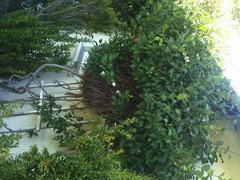
north_tx_gardener
13 years agochristinela - I can't quite tell from the picture exactly what you've got going on. The small white blooms look like Confederate Star Jasmine. I'm not sure which plant you're calling a boxwood. I don't believe the largest plant in the photo is a boxwood. If it's one plant is it a large Confederate Jasmine that's way outgrown the trellis behind it? They have a wonderful fragrance. If you haven't done anything yet, try to find out if it's 1 or 2 plants you're dealing with.




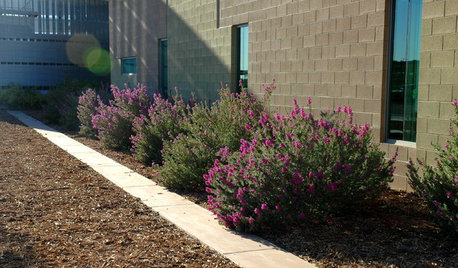

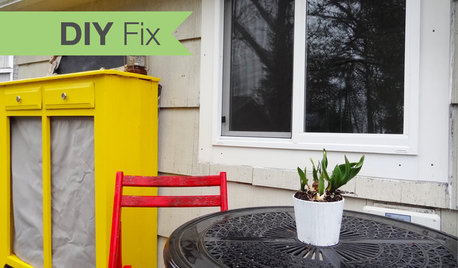
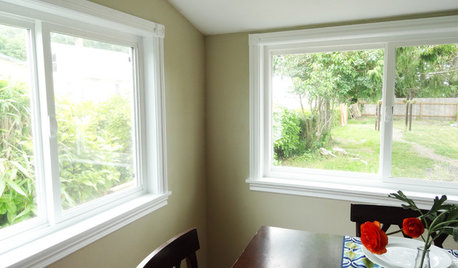
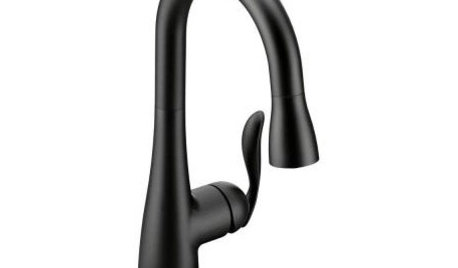
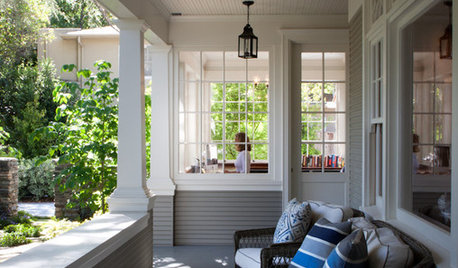






Jungle_Jim